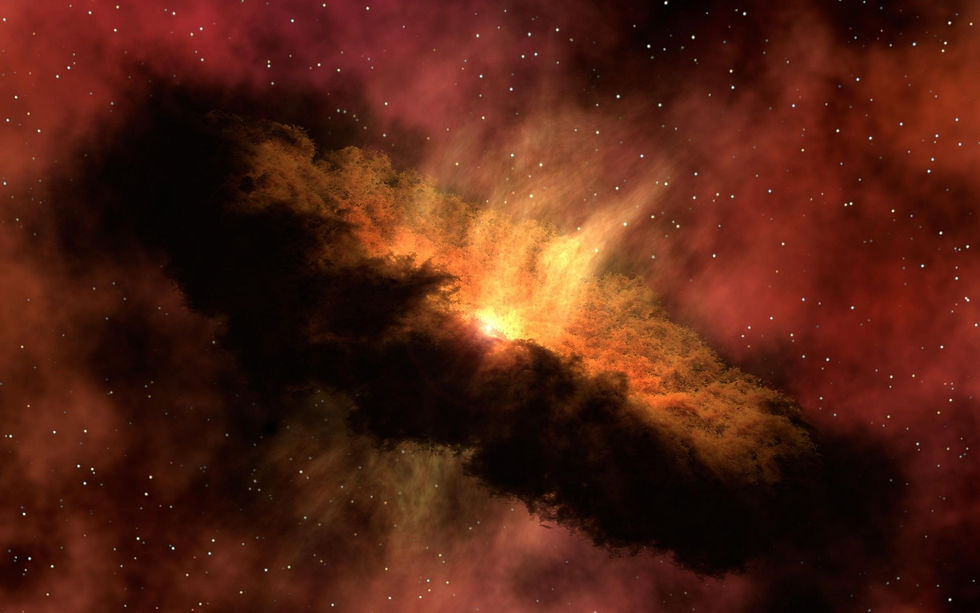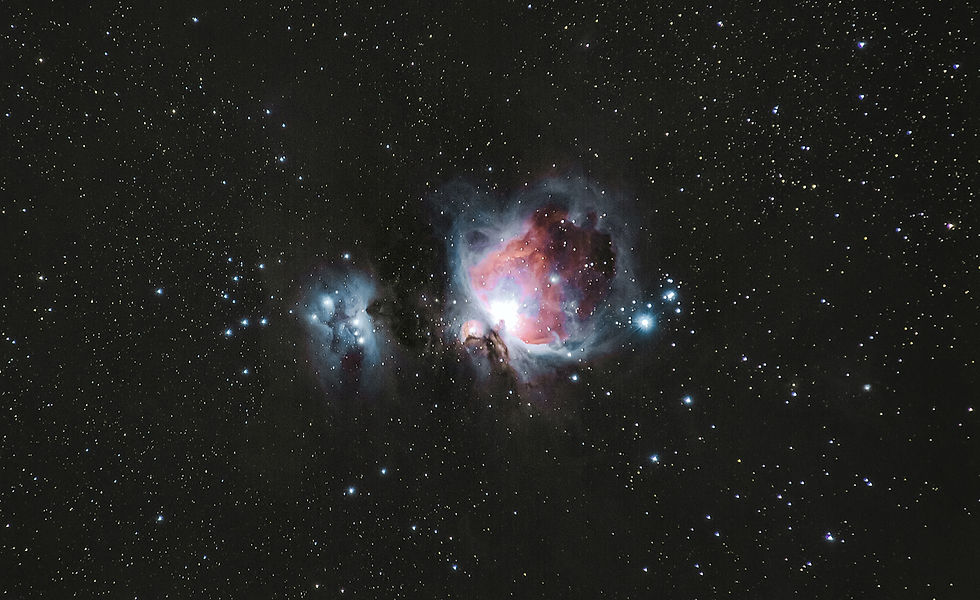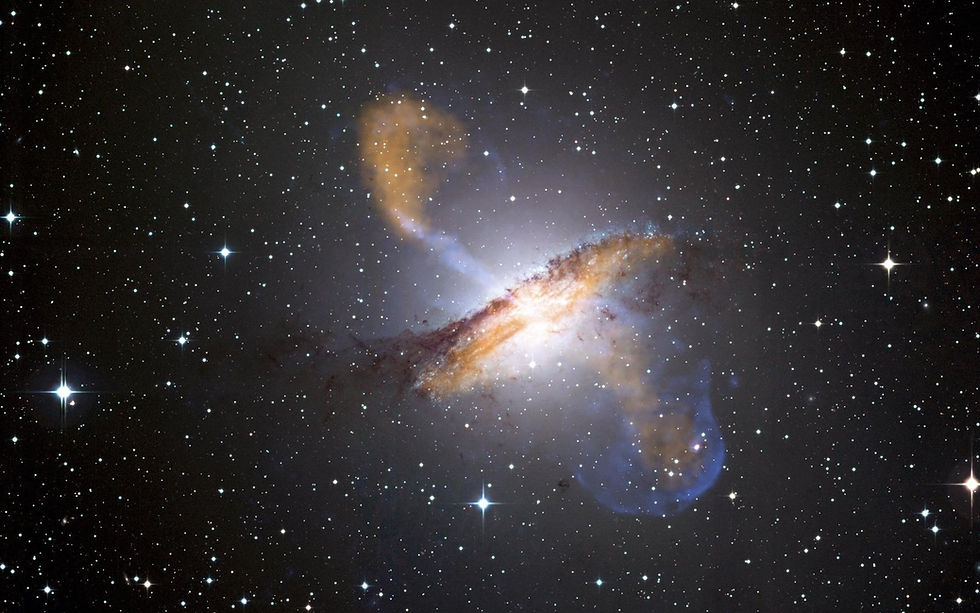Stellar Nurseries: Unraveling the Mysteries of Nebulae and the Birth of Stars
- Dhruv Hegde
- Aug 1, 2023
- 4 min read
Updated: Aug 5, 2023
Author: Afreen Hossain - Astronomy Cohort - August 5th, 2023

Photo by Pixabay
Nebulae are vast clouds of gas and dust that exist in the interstellar medium. These nebulae are often hundreds or thousands of light-years across and serve as the birthplaces of stars. The process of star formation begins when some disturbance, such as a shockwave* from a nearby supernova or the gravitational influence of a passing star, causes a small region within the nebula to contract. As this region of the nebula contracts, gravity becomes the dominant force pulling the gas and dust particles closer together. As more matter accumulates at the center, the gravitational force further strengthens, leading to an accelerating collapse. This collapsing region is called a protostellar core.
(*A shockwave is a type of propagating disturbance that moves through a medium, carrying energy and momentum with it. It is characterized by a rapid and abrupt change in pressure, temperature, density, and velocity of the medium it passes through. Shockwaves can be generated by a variety of events and processes, and they play significant roles in different fields of science and engineering.)
Inside the protostellar core, temperatures and pressures increase dramatically due to the compression of the gas and dust. As the core's temperature rises to around 15 million degrees Celsius, a critical point is reached. The temperature and pressure at the core become high enough for nuclear fusion to ignite nuclear fusion and the main sequence. At this point, nuclear fusion reactions commence, and hydrogen atoms in the core combine to form helium through a process known as nuclear fusion. This marks the birth of a star, and it enters the main sequence phase of its life.
During the main sequence phase, the star stabilizes, and a delicate balance is achieved between the inward force of gravity trying to collapse the star and the outward pressure generated by the nuclear fusion reactions in the core. This equilibrium allows the star to maintain a stable size and energy output for a significant portion of its lifetime.
Depletion of hydrogen over time, the star consumes its core hydrogen fuel through nuclear fusion as the core hydrogen depletes, the outward pressure decreases, and the balance between gravity and pressure is disrupted by the expanding outer layers. The star's core contracts and heats up while the outer layers expand. This expansion causes the star to grow significantly in size, becoming much larger than its original main sequence size. red giant appearance This phase is known as the red giant phase, named after the star's reddish appearance due to its lower surface temperature.
The helium fusion core temperature increases as the red giant's core contracts and becomes hotter and denser. The increased temperature and pressure allow for helium nuclei to fuse together, forming heavier elements like carbon and oxygen. multiple helium shell flashes The process of helium fusion can lead to multiple helium shell flashes where helium burning occurs in shells surrounding the inert core. These flashes cause the outer layers of the star to expand and contract in complex cycles.

Photo by Alex Andrews
Planetary nebulae and white dwarf ejection of outer layers as the red giant continues to evolve. The outer layers of the star are ejected into space through powerful stellar winds and intense radiation. This ejected material forms a glowing shell of gas and dust around the central core. planetary nebula formation The glowing shell of gas and dust is known as a planetary nebula, even though it has no direct connection to planets. The name comes from its visually similar appearance to the blurry round shapes of distant planets observed through early telescopes. white dwarf: after the outer layers are expelled, the remaining core contracts and becomes a dense, earth-sized remnant known as a white dwarf. The white dwarf is incredibly hot and slowly cools down over billions of years. More massive stars go through a different fate as their cores run out of nuclear fuel to burn and can no longer support the gravitational collapse. The core's collapse rapidly increases, leading to an explosive event known as a supernova explosion.
During a supernova, the star releases an enormous amount of energy, briefly outshining entire galaxies. The explosion is so bright that it can briefly outshine the entire galaxy. It was part of heavy element formation. Supernovae are responsible for producing and dispersing heavy elements like gold, silver, and uranium into space, enriching the interstellar medium with these elements that will be used in the formation of future stars and planets.
Neutron stars: If the mass of the core left after a supernova is around 14 times that of the sun, the Chandrasekhar limit, it becomes a neutron star. A neutron star is incredibly dense and composed almost entirely of neutron black holes. In cases where the core mass is even more massive than the Chandrasekhar limit, it continues to collapse and nothing can stop it. The core becomes so dense that it forms a region in spacetime with gravitational forces so strong that not even light can escape from it. This is what we call a black hole
.
The entire life cycle of a star, from its formation as a protostar to its eventual fate as a white dwarf neutron star or black hole, is a complex and awe-inspiring journey that shapes the universe we observe today. Stellar evolution is a fundamental process that influences the creation and distribution of elements and matter across the cosmos.
References:
.png)






Comments